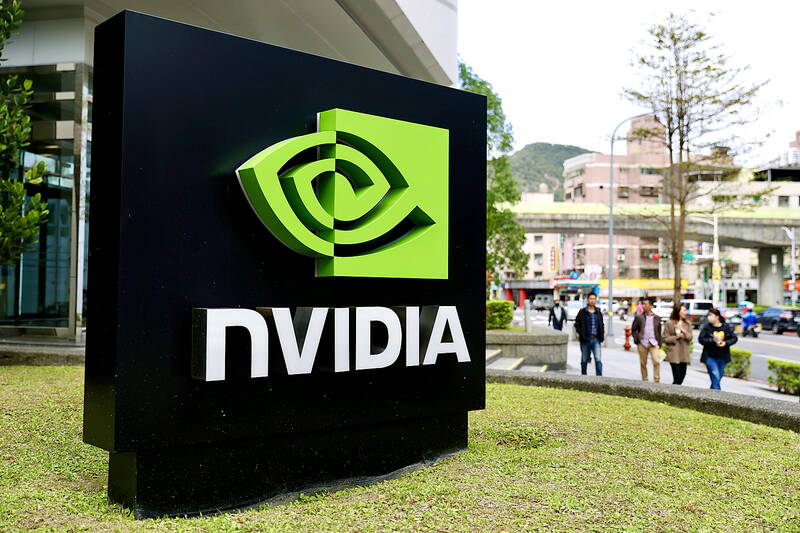Nvidia Corp’s first artificial intelligence (AI) research and development center in Asia, which is being built in Taiwan, is 40 percent complete, Department of Industrial Technology (DOIT) Director-General Chiou Chyou-huey (邱求慧) said.
The five-year project, which was started last year, seeks to hire 1,000 employees, build a supercomputer, named "Taipei-1," and work with Taiwan’s industry and research institutions to develop AI technologies and products, according to the Ministry of Economic Affairs.
Chiou told CNA that as the project enters its second year, up to 400 R&D-related employees have been employed.

Photo: EPA-EFE
On the hardware side, the installment of "Taipei-1" was completed at the end of last year, he said.
Asked about the supercomputer, Chiou said it consists of 64 Nvidia DGX H100, with each DGX H100 composing eight H100 graphic processing units (GPUs).
A GPU is a computer chip that has overtaken the traditional central processing unit (CPU) to become the most important computing technology in the AI era.
As of last year, H100 GPU was considered Nvidia’s most advanced — and the world’s most powerful GPU — powering Meta Platforms Inc and ChatGPT-maker OpenAI for generative AI training and inference.
The supercomputer also has 32 OVX computing systems, which are designed to build 3D virtual worlds and immersive digital twin simulations that have wide applications such as product development for manufacturing or better personalized care in healthcare.
As per the agreement with the ministry, a quarter of Taipei-1’s computing power will be provided to Taiwanese companies and research institutions to use for free for six weeks from July this year to February 2027 upon application, Chiou said.
He said the application, which closes at the end of this month, is open to all kinds of institutions, companies and start-ups for non-commercial use.
The supercomputer is situated in Kaohsiung, he added.
Meanwhile, Chiou denied a local report claiming a "second" R&D center is to be built.
"Nvidia’s R&D center is not one single building, so there is no question of a ’second’ one, as the company’s R&D projects are placed around the country," Chiou said.
According to the department’s Web site, Nvidia’s AI R&D center project was approved in December 2021, with the ministry providing a subsidy of NT$6.7 billion (US$206.7 million) and the company investing NT$17.6 billion.
Nvidia setting up its first AI R&D center in Asia in Taiwan is part of the government’s "Supreme A+ Program" — initiated in 2020 — to attract global pioneers in innovation to invest in state-of-the-art technologies in semiconductors, communications and AI in Taiwan.
US company Micron Technology Inc was granted a subsidy of NT$4.7 billion in 2021 under the same program for a project that focuses on developing advanced memory technologies.

When an apartment comes up for rent in Germany’s big cities, hundreds of prospective tenants often queue down the street to view it, but the acute shortage of affordable housing is getting scant attention ahead of today’s snap general election. “Housing is one of the main problems for people, but nobody talks about it, nobody takes it seriously,” said Andreas Ibel, president of Build Europe, an association representing housing developers. Migration and the sluggish economy top the list of voters’ concerns, but analysts say housing policy fails to break through as returns on investment take time to register, making the

NOT TO WORRY: Some people are concerned funds might continue moving out of the country, but the central bank said financial account outflows are not unusual in Taiwan Taiwan’s outbound investments hit a new high last year due to investments made by contract chipmaker Taiwan Semiconductor Manufacturing Co (TSMC, 台積電) and other major manufacturers to boost global expansion, the central bank said on Thursday. The net increase in outbound investments last year reached a record US$21.05 billion, while the net increase in outbound investments by Taiwanese residents reached a record US$31.98 billion, central bank data showed. Chen Fei-wen (陳斐紋), deputy director of the central bank’s Department of Economic Research, said the increase was largely due to TSMC’s efforts to expand production in the US and Japan. Investments by Vanguard International

EARLY TALKS: Measures under consideration include convincing allies to match US curbs, further restricting exports of AI chips or GPUs, and blocking Chinese investments US President Donald Trump’s administration is sketching out tougher versions of US semiconductor curbs and pressuring key allies to escalate their restrictions on China’s chip industry, an early indication the new US president plans to expand efforts that began under former US president Joe Biden to limit Beijing’s technological prowess. Trump officials recently met with their Japanese and Dutch counterparts about restricting Tokyo Electron Ltd and ASML Holding NV engineers from maintaining semiconductor gear in China, people familiar with the matter said. The aim, which was also a priority for Biden, is to see key allies match China curbs the US

STRUGGLING TO SURVIVE: The group is proposing a consortium of investors, with Tesla as the largest backer, and possibly a minority investment by Hon Hai Precision Nissan Motor Co shares jumped after the Financial Times reported that a high-level Japanese group has drawn up plans to seek investment from Elon Musk’s Tesla Inc to aid the struggling automaker. The group believes the electric vehicle (EV) maker is interested in acquiring Nissan’s plants in the US, the newspaper reported, citing people it did not identify. The proposal envisions a consortium of investors, with Tesla as the largest backer, but also includes the possibility of a minority investment by Hon Hai Precision Industry Co (鴻海精密) to prevent a full takeover by the Apple supplier, the report said. The group is